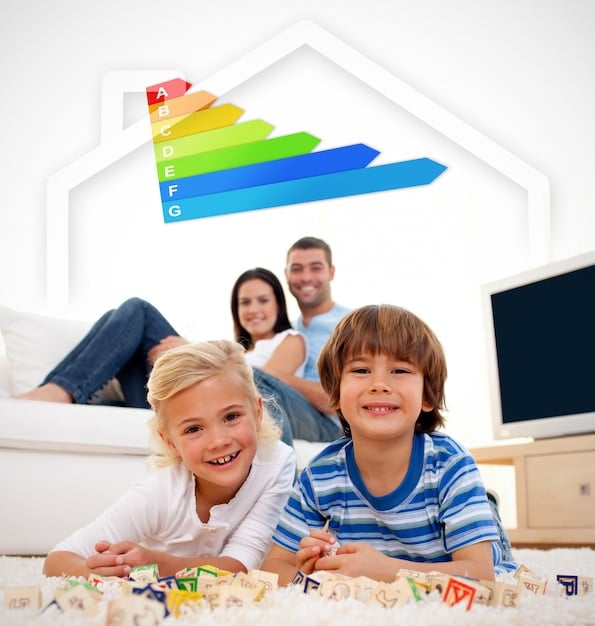Energy Assistance Programs: Get Help Paying Utility Bills

Energy assistance programs, funded by the federal and state governments, provide financial aid to low-income households to help manage and lower their utility bills, ensuring access to essential energy services.
Are you struggling to keep up with your energy bills? You’re not alone. Many households face challenges in affording essential utilities. Fortunately, energy assistance programs are available to provide financial relief. By applying for federal and state aid, you can lower your utility bills and ensure your home remains comfortable and safe.
Understanding Energy Assistance Programs
Energy assistance programs are designed to assist low-income households in managing their energy costs. These programs, funded by both federal and state governments, aim to alleviate the burden of high utility bills, making energy more affordable for vulnerable populations. Understanding these programs is the first step toward accessing the financial aid you need.
These programs operate under various guidelines and eligibility criteria, each designed to target specific demographics and needs within the low-income community. This ensures that assistance is provided to those who require it most, improving their quality of life and financial stability.
The Purpose of Energy Assistance
The primary purpose of energy assistance is to ensure that all households have access to essential energy services, regardless of their income level. By providing financial aid, these programs help prevent energy shut-offs, keeping homes warm in the winter and cool in the summer.
Who Benefits from These Programs?
Energy assistance programs benefit a wide range of individuals and families, including seniors on fixed incomes, families with young children, individuals with disabilities, and those facing temporary financial hardships. These programs provide a safety net, ensuring that these vulnerable populations can maintain a basic standard of living.

- Preventing Energy Shut-Offs: Ensuring continuous access to energy services is crucial for health and safety.
- Reducing Financial Stress: Lower utility bills free up household budgets for other essential needs.
- Improving Living Conditions: Maintaining a comfortable home temperature contributes to better health and well-being.
In conclusion, energy assistance programs play a pivotal role in supporting low-income households by ensuring they can afford essential energy services. By understanding the purpose and benefits of these programs, more people can take advantage of the financial aid available and improve their overall quality of life.
Federal Energy Assistance: LIHEAP
The Low Income Home Energy Assistance Program (LIHEAP) is a federally funded program that helps low-income families with their energy bills. LIHEAP provides financial assistance for heating and cooling costs, energy crisis assistance, and weatherization services. Understanding LIHEAP and how to apply can significantly ease your financial burden.
LIHEAP is administered by individual states, each with its own set of eligibility requirements and benefit levels. This decentralized approach allows for flexibility in addressing the specific energy needs of different regions and populations, ensuring that the assistance is tailored to local circumstances.
Eligibility Requirements for LIHEAP
Eligibility for LIHEAP typically depends on income, household size, and energy costs. Priority is often given to households with the lowest incomes and those with vulnerable members, such as seniors and individuals with disabilities. Specific income thresholds vary by state.
How to Apply for LIHEAP
To apply for LIHEAP, contact your local state or tribal LIHEAP office. You will need to provide documentation of your income, household size, and energy bills. The application process may involve completing an application form, providing supporting documents, and attending an interview.

- Contacting Your Local Office: Locate the LIHEAP office in your state or tribal area.
- Providing Documentation: Gather necessary documents such as proof of income and energy bills.
- Completing the Application: Fill out the application form accurately and completely.
In summary, LIHEAP offers crucial federal support to low-income families struggling with energy costs. By understanding the eligibility requirements and application process, you can take the necessary steps to access this valuable resource and alleviate your financial burden.
State Energy Assistance Programs
In addition to LIHEAP, many states offer their own energy assistance programs to supplement federal aid. These state programs often provide additional benefits and target specific needs within the state. Exploring state-level assistance can uncover further opportunities to lower your utility bills.
State energy assistance programs are designed to complement federal initiatives, addressing gaps and providing targeted support to specific demographics within the state. These programs often reflect the unique economic and energy-related challenges faced by each state, ensuring a comprehensive approach to energy affordability.
Examples of State Programs
Some states offer programs like the California Alternate Rates for Energy (CARE) and the New York Energy Assistance Program (HEAP). These programs provide discounts on energy bills, payment assistance, and energy efficiency upgrades. Research programs available in your state to maximize your benefits.
How to Find State Programs
To find energy assistance programs in your state, visit your state government’s website or contact your local social services agency. These resources can provide detailed information on eligibility requirements, application processes, and benefit levels.
In conclusion, state energy assistance programs serve as a valuable supplement to federal initiatives, offering additional support and addressing specific needs within each state. By researching and understanding the programs available in your state, you can further reduce your utility bills and improve your financial stability.
Energy Efficiency Tips to Lower Bills
Beyond financial assistance, adopting energy efficiency practices can significantly lower your utility bills. Simple changes in your daily habits and home improvements can lead to substantial savings. By implementing these tips, you can reduce your energy consumption and lower your monthly expenses.
Adopting energy efficiency measures not only reduces your energy bills but also contributes to environmental sustainability. By using less energy, you can decrease your carbon footprint and promote a more sustainable lifestyle. These practices benefit both your wallet and the planet.
Simple Energy-Saving Practices
Turn off lights when you leave a room, unplug electronics when not in use, and use energy-efficient light bulbs. These small changes can add up to significant savings over time.
Home Improvements for Energy Efficiency
Insulate your home, seal air leaks, and upgrade to energy-efficient appliances. These investments can provide long-term savings on your energy bills and improve your home’s comfort.
- Sealing Windows and Doors: Prevent drafts by sealing gaps around windows and doors.
- Using Programmable Thermostats: Set your thermostat to automatically adjust the temperature when you are away or asleep.
- Regular HVAC Maintenance: Ensure your heating and cooling systems are running efficiently with regular maintenance.
In summary, combining energy efficiency practices with financial assistance programs offers a comprehensive approach to lowering your utility bills. By adopting these tips, you can reduce your energy consumption, save money, and contribute to a more sustainable future.
Navigating the Application Process
Applying for energy assistance programs can sometimes be complex, but understanding the process can make it easier. Prepare all necessary documents, follow application instructions carefully, and seek help from local agencies if needed. A well-prepared application increases your chances of receiving assistance quickly.
Many resources are available to help you navigate the energy assistance application process, including community organizations, social service agencies, and online guides. These resources can provide valuable assistance in gathering documents, completing applications, and understanding eligibility requirements.
Common Application Challenges
Applicants often face challenges such as gathering required documents, understanding eligibility criteria, and completing complex application forms. Being prepared and persistent can help overcome these challenges.
Resources for Application Assistance
Local community organizations, social service agencies, and online resources can provide assistance with the application process. These resources offer guidance, support, and information to help you navigate the system successfully.
- Gathering Required Documents: Understand what documents you need and collect them in advance.
- Completing the Application Form: Fill out the application accurately and completely.
- Following Up on Your Application: Check the status of your application and respond to any requests for additional information promptly.
In conclusion, navigating the application process for energy assistance programs requires preparation, persistence, and access to reliable resources. By understanding the common challenges and seeking assistance when needed, you can increase your chances of receiving the financial aid you deserve.
Advocating for Energy Assistance Programs
Supporting and advocating for energy assistance programs helps ensure they continue to serve those in need. Contact your elected officials, raise awareness in your community, and support organizations that promote energy affordability. Your voice can make a difference in the lives of many.
Advocating for energy assistance programs is crucial for ensuring that these vital resources remain accessible to low-income households. By raising awareness and supporting policies that promote energy affordability, you can help create a more equitable and sustainable energy system for all.
How to Get Involved
You can get involved by contacting your elected officials, writing letters, attending community meetings, and supporting organizations that advocate for energy assistance. Every action, no matter how small, can contribute to a larger movement for energy justice.
The Impact of Advocacy
Advocacy can influence policy decisions, increase funding for energy assistance programs, and raise public awareness about the importance of energy affordability. Your voice can help shape the future of energy assistance in your community and beyond.
- Contacting Elected Officials: Communicate the importance of energy assistance to your representatives.
- Supporting Advocacy Organizations: Donate to or volunteer with groups that advocate for energy affordability.
- Raising Community Awareness: Share information about energy assistance programs with your friends, family, and neighbors.
In summary, advocating for energy assistance programs is essential for ensuring that these crucial resources continue to support low-income households. By getting involved, you can help make a difference in the lives of those who struggle to afford their energy bills and promote a more just and sustainable energy system.
| Key Point | Brief Description |
|---|---|
| 💡 LIHEAP | Federally funded program assisting low-income families with energy bills. |
| 💰 State Programs | State-specific programs provide additional energy bill assistance. |
| 🏠 Energy Efficiency | Adopting practices like using efficient appliances can lower bills. |
| 📢 Advocacy | Supporting energy assistance programs ensures continued support for those in need. |
Frequently Asked Questions (FAQ)
▼
LIHEAP, or the Low Income Home Energy Assistance Program, is a federally funded program that helps low-income households with their energy bills, providing assistance for heating and cooling costs.
▼
Eligibility for energy assistance programs typically depends on factors like income, household size, and energy costs. Priority is often given to households with the lowest incomes and vulnerable members.
▼
To apply for LIHEAP, you should contact your local state or tribal LIHEAP office. They will provide information on the application process and eligibility requirements specific to your area.
▼
Simple energy-saving practices include turning off lights when leaving a room, unplugging electronics when not in use, using energy-efficient light bulbs, and sealing windows and doors to prevent drafts.
▼
You can advocate for energy assistance programs by contacting your elected officials, supporting organizations that promote energy affordability, and raising awareness in your community about the importance of these programs.
Conclusion
In conclusion, managing utility bills can be challenging, but with the aid of energy assistance programs and energy-efficient practices, it is possible to alleviate the financial burden. Explore both federal and state programs, adopt energy-saving habits, and advocate for these vital resources to ensure everyone has access to affordable energy.





